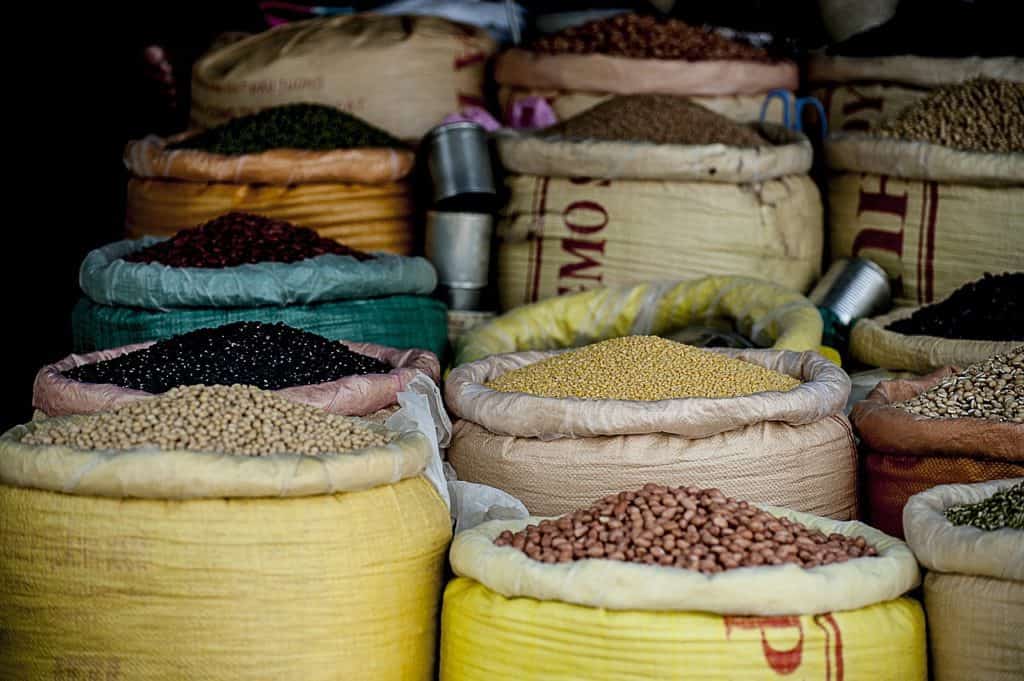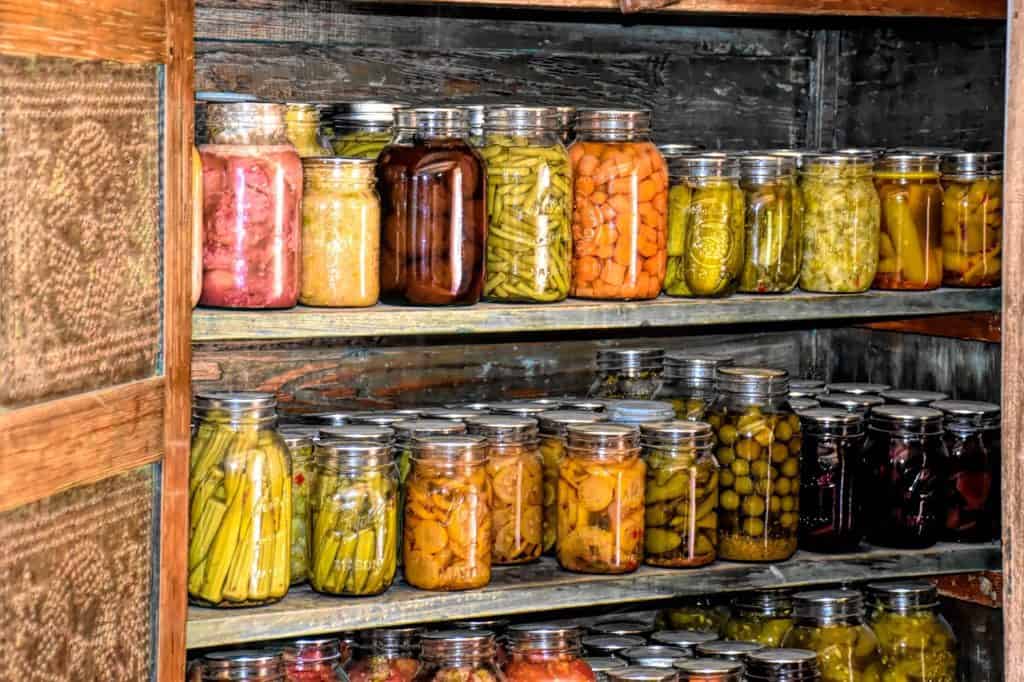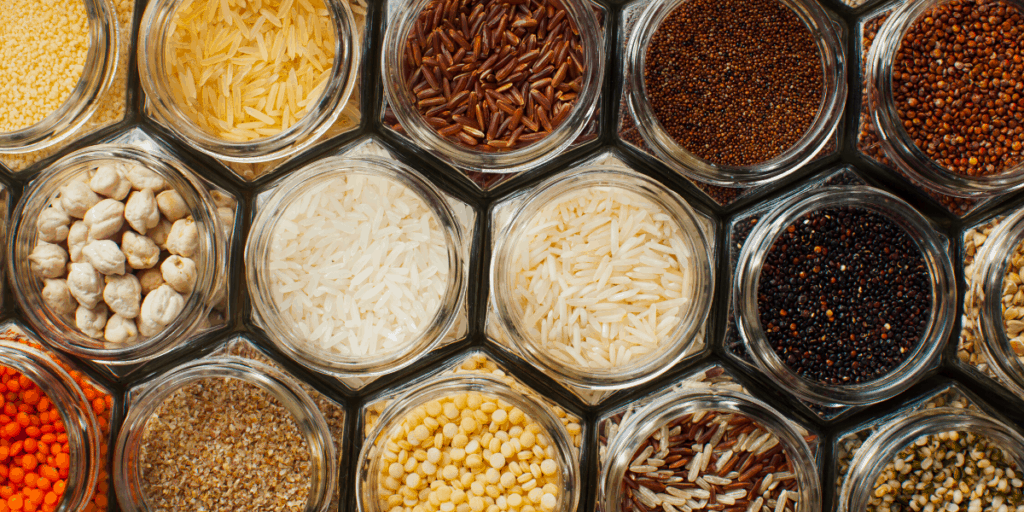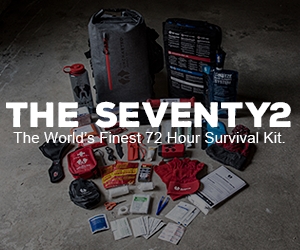Last Updated on October 31, 2020 by
Learning about long term food storage can seem daunting at first. Where do you start? What is the best food to store long term? What are the best long term food storage containers? How do I package my food so it doesn’t spoil? What foods last the longest?
These are some of the many questions I’ve personally had as I continue through my own journey and I’m sure that’s what landed you on this blog post – because you have the same questions.
Today we are going to focus on long term food storage containers because there is a lot to cover on this topic alone. You will find littered throughout this article information helping you with the other questions mentioned above as well.
So let’s get started!
Essentials For Long Term Food Storage
To begin, let’s first talk about the essentials of long term food storage. They are as follows:
- Temperature
- Type of Food
- Type of Container/Packaging
- Keeping Away From Pests
- Moisture
- Oxygen
- Rotation
We will talk about all of these in more detail below. The various aspects of food storage have been broken down into different categories to allow you to understand the concepts of each one better.
5 Most Important elements to get right when storing food long term

A good place to start is to talk about the things that are most harmful to your food storage planning. This is where it all starts. Knowing what his harmful to your food prep will help you lay the foundation for choosing the right containers and the right packaging methods for your food.
protect food from light
When it comes to food storage, one of the culprits to properly storing food is keeping it away from light. Exposing your food supplies to light will make your food deteriorate quicker then if you were to keep them in the dark.
Light is a form of energy and when your food is exposed to it for any length of time, some of the energy transfers to your food. This is what causes the degradation of nutritional value and appearance.
Fat soluble vitamins such as A,D, E, and K are especially sensitive to degradation because of the light. Anyone who knows about food preservation such as canning and packaging food into jars, that those jars need to be kept in a dark pantry somewhere away from the light.
The only time you should be exposing those jars to light is when you turn on the pantry light to retrieve one. The other option is to simply put them inside of the box that the jars came in, and store them in your garage with a lid, if you have one.
protection from pests
The first thing to know about food storage and pests is that there may already be pests in your food before you even get it.
Typically that’s what quality assurance is for in food manufacturing facilities, but the more common place to find pests would come from buying food items in bulk such as grains, rice, oatmeal, etc.
I’ll never forget the time when I went to cook some rice and I pulled out a one-pound plastic bag of rice to find winged little critters flying out of it when I opened it! Yuk! It was a bag I had probably opened a long time before, then didn’t seal it properly and the bugs got it. I should of used a Seal-A-Meal or something to that effect.
If you are someone who has a big pantry and is storing emergency food, you can get some sort of pest traps to control any potential insects from contaminating any food items.
In the end, the best way to keep bugs out of your food storage is to make sure your long term food storage containers are air-tight. We will look at that topic more below.
keep food dry and away from moisture
Moisture and humidity will surely kill all of your food storage efforts. Humidity and oxygen speed microbiological and mold growth and can make your food unsafe to eat. You should try to store your food below 10% humidity if possible.
To help keep moisture from forming, all containers should be kept off the floor and out of direct contact from exterior walls to reduce the chances of condensation brought on by temperature differences between the container and the surface it’s resting against.
The key again is proper packaging such as mylar bags with oxygen absorbers inside protected by food-grade 5-gallon buckets. Oxygen absorbers are vital to any long term food storage efforts.
Those little packets are essentially filled with iron powder. The packet will absorb about 99% of oxygen that is present when the package is sealed.
keep food stored at proper temperature
The bottom line rule of thumb when storing food is the colder temperature the better. This is why root-cellars can make for a great, naturally low-temperature place to store food.
On the adverse side of cold is heat. Heat will completely ruin any chances you have of keeping your food preps for any length of time. Make sure to keep your long term food items stored at temperatures no higher than 70 degrees Fahrenheit.
keep food storage containers air-tight
Oxygen is another one of those nasty things that can ruin your food storage plans. Although we need it as humans to survive, we don’t need it when it comes to long term food storage.
Oxygen is so bad for food that some companies even take all of the oxygen out of their canned and sealed products then put back nitrogen gas inside to fill the empty space and prevent any oxygen from getting in.
You may have purchased some type of hermetically-sealed package, such as emergency ration bars, that are essentially vacuumed-sealed to remove all of the oxygen. This is because emergency ration bars are a survival food, and need to have a shelf-life of at least five years.
Some of the best 5-gallon buckets you can buy have gamma seal lids on them, which make them an excellent choice for food storage.
Long Term Food Storage Options

As preppers, we are all focusing on the long-term, not-knowing-when-we’ll-need-it type of food items. One of the most important things to get right when storing food is the actual food storage containers that you place your food items into.
Below I have outlined the five most highly-used long term food storage containers that you can use to keep all of your long-term food items.
PETE (polyethylene terephthalate) Plastic Bottles
When storing dried foods such as rice and grains, using a 2 Liter plastic soda container works very well. These plastic PETE bottles should be well cleaned before use. You should only use PETE bottles because other plastics may not provide enough of a moisture barrier.
You can be make sure that the plastic bottles are PETE due to the “PET” at the bottom of the bottle. It’s probably obvious, but you should never use any type of container that has housed non-food items. This could be a disaster and not safe for consumption.
You can easily label these clear plastic bottles with a sharpie with the type of food item and the date. But please be careful to store them a dark place because after all, they are clear bottles, so light will be able to easily enter.
Even though there is a small drainage of oxygen over time due to the fact the bottles are plastic, they still work as an excellent long term storage container that can easily be rotated throughout its life cycle.
Make sure to also use one oxygen absorber per 1 gallon container of dried goods that has a moisture percentage of 10% or less.
Glass Jars
Glass jars, specifically mason jars, are a fantastic way to store and preserve all kinds of food from vegetables and fruit to meats and sauces.
In terms of storing dried food long term in mason jars, they aren’t really used for that unless you are wanting to store smaller quantities that you can easily get to. Typically mason jars are used for preserving other types of foods, as mentioned above.
Besides the normal sized mason jars, you can also easily purchase half-gallon and gallon-sized mason jars to store things such as sugar and powdered milk. It just depends on what your intentions are for storage.
Just make sure that you include an oxygen absorber on the top of each jar before you seal it. Also make sure to always use new lids and heat them in simmering water so that it softens the rubber gasket. A vacuum is created as the absorber takes out the oxygen from the air and eventually seals the jar.
Make sure to store your mason jars in a cool, dark place because they are clear, so you will need to keep them away from light.
#10 Cans
#10 cans are great for long-term food storage of dry (10 percent moisture or less) foods. The foods inside won’t react with the metal due to the food-grade enamel coating that lines the inside of the can.
That’s what makes them so special. Believe it or not, you can even store olive oil in these cans!
The other valuable aspect is that cans are great for keeping mice out of your food. You will notice that many of the survival food companies like Auguson Farms uses #10 cans for their survival food.
#10 cans have been around a long time and have been used for long-term food storage. It can sometimes be difficult to find them, but I found a great blog post that explains everything you need to know and where you should be able to find them in the most detail from GunsAmerica.com.
LDS Canneries (now Home Storage Center) used to be the best place to buy #10 cans, but they closed their canneries and now most people go to get them from other companies such as Wellscan.ca and BerlinPackaging.com.
And remember, make sure you always keep these cans stored in a cool, dry place because even though they are safe from mice, they can still rust if they get too wet.
Mylar Food Storage Bags
Food-Grade Plastic Buckets
You have probably seen the 5-gallon food-grade plastic buckets that many of the best survival food kits are packaged in. There is a reason for this. These food-grade plastic buckets that have gasket seals in the lid. This ensures proper, air-tight storage and ensures long shelf-life.
It might be tempting to use other 5-gallon buckets that didn’t hold food in the first place. Just like the plastic PETE bottles, don’t do this, even if put your food in mylar bags first.
The great thing about plastic food storage buckets is that you can take your food items you’ve purchased at the store and keep them in their original packaging and place them inside of the buckets them seal those buckets.
Those food storage buckets are designed to add an extra layer of protection from pests such as bugs, mice, and moisture. One of my favorite buckets are the 5-gallon ones that have the gamma seal lids that come with them!
how to Correctly Package Food and keep it fresh and free from bugs
Packing and storing food isn’t as simple as just buying a 5-gallon storage bucket and pouring some rice in it then sealing it and throwing it on a shelf.
That will surely not keep your food as long as you need it and it will certainly be vulnerable to insects such as rice weavils, mealmoths, and grain beetles.
Below are some important practices that are used for long term food storage.
dry ice
Storing food with dry ice is an alternative to using oxygen absorbers. Even though it’s a little more complicated, it can be cheaper if you can get it locally in a store. One of the biggest issues is that you could accidentally use too much dry ice and it pops the lid off of the bucket!
Dry ice is basically carbon dioxide (CO2) that is used for a variety of different ways, typically to keep things cool. It is heavier than air and displaces oxygen. If you are going to use dry ice to treat your food storage, it’s safest to use if for grains and legumes and stored inside plastic buckets.
Dry ice should take care of most adult and larva-stage insects, but it won’t destroy eggs.
oxygen absorbers
One of the most common ways to properly store foods such as rice, grains, and legumes is by using oxygen absorbers within a sealed mylar bag, then sealing that bag within a 5-gallon bucket.
Removing all of the oxygen out of the packages are so vital to your food storage plans. The iron dust hits oxygen it reacts and removes all of the oxygen out. To determine what size of oxygen absorber you should use for each size of long-term food storage container, you can reference USA Emergency Supply.
A good trick that I just learned recently is that you can freeze your rice 3-4 days to make sure that you kill any possible insect larva that could be in your pre-packaged store-bought food items, then take the item back out and thaw to room temperature and then attempt to package. I thought that was a great idea!
It’s best practice to then put your dried food items such as rice or grains in mylar bags that are made for 5-gallon buckets, seal them tightly with the oxygen absorbers inside, and then place them in the 5-gallon food storage buckets.
You can use a regular clothes iron, as shown below in the video, to seal your mylar bags, or you can buy a handheld heat sealer specifically designed for sealing this type of bag.
PackFresh USA also makes a great little “kit” for food storage that includes mylar bags made for 5-gallon buckets and oxygen absorbers or you can simply pick up some oxygen absorbers by themselves online.
Diatomacious earth
Using diatomaceous earth (DE) for storing food has been around for a very long time. Several cultures have mixed diatomaceous earth to store their grain in order to protect it from insects. We still do this same practice today in the agriculture industry for livestock grains and feed.
The more applicable situation for today’s topic is that diatomaceous earth can also be used to help preserve food preps such as grains, rice, beans, corn, and other dried food.
Diatomaceous earth is designed to not only kill insects and get rid of them, it is also used to absorb moisture. It’s a fantastic way to naturally preserve your food. All you need is a bag of 100% food grade diatomaceous earth and a kitchen sieve.
It is recommend applying about 1 teaspoon of diatomaceous earth for every pound of food (or 1 cup of diatomaceous earth for every 50 lbs. of food, if you are storing large quantities).
If you are placing food items into long-term storage, it is recommend increasing the amount of diatomaceous earth to 1½ or 2 teaspoons for every pound of food.
Desiccant/Silica Gel
As you’ve learned, moisture is one of the biggest detriments to your food storage efforts. In order to help keep moisture and humidity under control, silica gel packets can be used and are perfect for mason jars, for example.
Here’s a few notes about silica gel packets:
- Silica gel packets ARE NOT the same as oxygen absorbers. Silica gel packets desiccants are designed for removing moisure through adsorption and oxygen absorbers are designed to remove oxygen through absorption.
- Never try and reuse silica gel packets. They simply don’t work after they’ve been used once. You can try and reactivate them if you want, but since they are so cheap, you’d be better off just using new ones for each food item you want to preserve.
- NEVER consumer silica gel packets (even though they are non-toxic in the short term). They aren’t a food item so don’t eat ’em!
- Do not use the blue colored gel packets for storing food as they are toxic. Only use food-grade silica gel packets.
To use silica gel packets you simply will layer the small packets throughout the long term food storage container and then seal it right away. Make sure to get rid of the packets once you open the food item for use.
Also it’s important to note that the desiccant should not be placed anywhere near an oxygen absorber as it can adversely change the effectiveness of the oxygen absorber. The silica gel packets should be placed at the bottom or throughout the food item being stored.
Which Type Of Food Lasts The Longest?

You will learn quite quickly that there are certain foods that last longer and can be preserved better than others. There are several foods that can last almost forever, which make excellent foods to store long term.
There are many questions surrounding food preparation and storage and one of the biggest ones is “what are the best foods for long-term storage?”. I’ve covered this in detail in an earlier post titled, 24 Foods That Last Forever.
It will break down all of the foods that you can store and it will give you a great place to start in your food storage journey.
How To Rotate Your Long Term Food Storage

One of the last things I wanted to mention briefly is about rotating your long-term food storage supplies. This is an important aspect which you must consider as you continue to learn more about storing food.
As preppers we have no idea when the ball might drop. We have to be prepared at any time to handle what disaster might come our way. Part of the preparation is making sure our food is as fresh as possible and none of it has expired in the meantime.
To do this, food rotation is a good idea. This keeps you on your toes and allows you to create a system of checks and balances for food storage and making sure no insects have compromised any of the food.
With food rotation, you don’t want to eat the freshest food and save the oldest for last. That’s why you have to adopt the first-in-first-out (FIFO) method of rotating your food. If you date all of your food when you pack it (which you should be), you should be using those pack dates as the method.
Maybe you want to create a simple rule of pulling from left to right. Make a method, however you and your family would like to do it, and stick with it.
Food rotation is a great practice because you can be inspecting your food for pest infestation or your canned food for spoiling, etc. You will also have the opportunity to do inventory checks and determine where you’re at in your food supply situation.
Last Minute Thoughts
Food storage and preparation is an ongoing learning experience. Trust me. I’ve learned so much over the past several months and I expect to continue my learning process as time goes on.
Long-term food storage containers are important to understand and I hope this blog post has helped shed some light on the subject.








